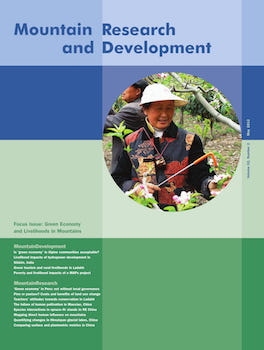Climate Change and Biodiversity in the Tropical Andes, edited by Sebastian K. Herzog, Rodney Martinez, Peter M. Jørgensen, and Holm Tiessen. São José dos Campos, Brazil and Paris, France: Inter-American Institute of Global Change Research (IAI) and Scientific Committee on Problems of the Environment (SCOPE), 2011. xii + 348 pp. Electronic copy only; free download from http://www.iai.int. ISBN 978-85-99875-05-6.
“La variedad de climas y la asombrosa diversidad de sus plantas y producciones, en los reinos animal, vegetal y mineral, presenta una fuente de abundancia donde pueden hallarse, y se hallan preciosos, inestimables tesoros,”
as the Bohemo-Austrian geographer and botanist Thaddäus Haenke wrote in 1810 (published posthumously in Haenke 1901: IX), with reference to the tropical Andes. More than 200 years later, climate change is affecting the “inestimable treasure” of biodiversity, as the title of this book suggests. The book is published under the Creative Commons Public License and includes 4 chapters on cross-cutting topics and 19 that provide background information. At first glance, this free publication stands out due to its online-only characteristic; a printed version in English is not available. In the introduction, the editors state that the aim is to provide a synthesis of the tropical Andes' biodiversity patterns and highlight their importance for humans by linking them to ecosystem services.
Chapter 1 introduces the topic of climate change patterns in the tropical Andes by linking it with observed and hypothesized effects on different ecosystems: from cloud forests to dry and humid puna grasslands. Provisioning, regulating, supporting, and cultural ecosystem services are distinguished, and their strong relationship to human societies is underlined. Chapter 2 analyzes the direct and indirect impacts of climate change on the biodiversity of the tropical Andes and offers a synthesis on conservation management tools and methods. With respect to possible obstacles that face biodiversity conservation, the authors mention a lack of institutional capacities, for example, that the Comunidad Andina de Naciones should play a decisive role in promoting practices of climate change adaptation. The authors of chapter 3 draw on the previous discussions, turning their attention to the effects of range shifts that may increase the risk of extinction to species. In addition, the authors request the—probably meaningful—adaptation of existing management tools to the geographic peculiarities of the tropical Andes, although without reasoning why. Part I finishes with a contribution on the impacts of climate change on phenology and interspecific interactions of Andean organisms, highlighting the differentiation between proximate and ultimate causes, and underlining the importance of long-term monitoring and predictive modeling.
Chapters 5–7 have a clear focus on the climate of the Andes; after some introductory notes on paleo-climate by Holm Tiessen, an overview of the current understanding of tropical Andean climatology is given through an analysis of decadal, interannual, and seasonal variability, followed by some explanations on the diurnal cycle. The authors distinguish between the very moist climate of the northern part (Colombia, Ecuador) and the tropical Andes' drier south (Peru and Bolivia). Subsequently, insights on climate-change evidence and future scenarios are offered. The contribution also includes several useful summary tables, which enable a comparative view on climatic tendencies, glacier retreat, and change projections.
Chapters 8–12 treat topics that relate to land use and ecosystem services. The “Introduction to Andean Geographies” aims at facilitating the assessment of the impacts of global change on plants, animals, and ecosystems. The authors cover aspects of geomorphology, atmospheric peculiarities, soil conditions, and Andean hydrogeography. However, the human dimension of “Andean Geographies” is reduced to the doubtlessly important impacts of rural land use on biodiversity; the manifold effects of Andean urbanization on local or regional climatic conditions, as well as on biodiversity, are simply ignored. Chapter 9 gives an interesting overview of Andean land use, which ranges from pre-Columbian to present times but, again, is confined to rural activities. After an interesting contribution on plant geography and floristic regions of the northern and central Andes, a well-structured overview on the vulnerability and resilience of Andean ecosystems is offered (for aquatic habitats, páramo, humid and dry puna as well as for cloud, seasonal, and dry Andean forest). Finally, climatic stress is exemplified by the Colombian Cordillera Central.
Chapters 13–20 address research on biodiversity. Articles on plant-diversity patterns are followed by others about climate-change impacts on fungi and mosses, insects, birds, and small mammals, and on the biodiversity of aquatic systems (lakes, rivers, and wetlands). Most of these contributions emphasize the existing elevation gradients and patterns; identify knowledge gaps; and, against the background of climate change, propose future directions of biodiversity research.
The final chapters, 21–23, concentrate on adaptation and mitigation strategies that relate to changes in climate and biodiversity. First, the limits and opportunities of species distribution modeling for biodiversity management are examined. Second, the role of protected areas as a tool for addressing global change is underlined, with an emphasis on these protected areas' suitability as monitoring sites. The last chapter identifies 5 priorities for sustainable flow management of Andean rivers, a need that involves both mountain societies and their environment.
In sum, a reader interested in biodiversity and climate change will find a very comprehensive and informative publication that regionally focuses on Colombia, Ecuador, Peru, and Bolivia. Part II, in particular, has a clear structure and a useful sequence. Several case studies exemplify the treated topics and make the reader think about the importance of the environment's “inestimable treasures” (Haenke 1901) for mountain societies. From a geographer's point of view, more attention to the impact of biodiversity change on the Andean people would have been interesting. Nevertheless, the 360 pages (or individual chapters) of the digital book, although they have a certain degree of information redundancy, are worth downloading free of charge from the Internet. Although a print-on-demand version would be a plus, it is good news that a free hard-copy Spanish translation will be published, and distributed upon request by the Universidad de los Andes (Venezuela).
Open access article: please credit the authors and the full source.





